
Gran Chaco
Encyclopedia
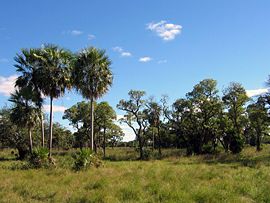
Lowland
In physical geography, a lowland is any broad expanse of land with a general low level. The term is thus applied to the landward portion of the upward slope from oceanic depths to continental highlands, to a region of depression in the interior of a mountainous region, to a plain of denudation, or...
region of the Río de la Plata
Río de la Plata
The Río de la Plata —sometimes rendered River Plate in British English and the Commonwealth, and occasionally rendered [La] Plata River in other English-speaking countries—is the river and estuary formed by the confluence of the Uruguay River and the Paraná River on the border between Argentina and...
basin, divided among eastern Bolivia
Bolivia
Bolivia officially known as Plurinational State of Bolivia , is a landlocked country in central South America. It is the poorest country in South America...
, Paraguay
Paraguay
Paraguay , officially the Republic of Paraguay , is a landlocked country in South America. It is bordered by Argentina to the south and southwest, Brazil to the east and northeast, and Bolivia to the northwest. Paraguay lies on both banks of the Paraguay River, which runs through the center of the...
, northern Argentina
Argentina
Argentina , officially the Argentine Republic , is the second largest country in South America by land area, after Brazil. It is constituted as a federation of 23 provinces and an autonomous city, Buenos Aires...
and a portion of the Brazil
Brazil
Brazil , officially the Federative Republic of Brazil , is the largest country in South America. It is the world's fifth largest country, both by geographical area and by population with over 192 million people...
ian states of Mato Grosso
Mato Grosso
Mato Grosso is one of the states of Brazil, the third largest in area, located in the western part of the country.Neighboring states are Rondônia, Amazonas, Pará, Tocantins, Goiás and Mato Grosso do Sul. It also borders Bolivia to the southwest...
and Mato Grosso do Sul
Mato Grosso do Sul
Mato Grosso do Sul is one of the states of Brazil.Neighboring Brazilian states are Mato Grosso, Goiás, Minas Gerais, São Paulo and Paraná. It also borders the countries of Paraguay and Bolivia to the west. The economy of the state is largely based on agriculture and cattle-raising...
, where it is connected with the Pantanal
Pantanal
The Pantanal is a tropical wetland and one of the world's largest wetland of any kind. Most of it lies within the Brazilian state of Mato Grosso do Sul, but it extends into Mato Grosso and portions of Bolivia and Paraguay, sprawling over an area estimated at between and...
region. This land is sometimes called the Chaco Plain.
Geography

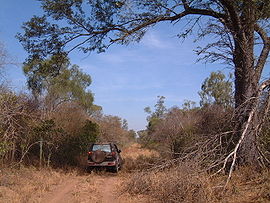
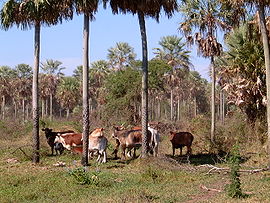
The Gran Chaco is about 647500 km² (250,001 sq mi) in size, though estimates differ. It is located west of the Paraguay River
Paraguay River
The Paraguay River is a major river in south central South America, running through Brazil, Bolivia, Paraguay, and Argentina...
and east of the Andes
Andes
The Andes is the world's longest continental mountain range. It is a continual range of highlands along the western coast of South America. This range is about long, about to wide , and of an average height of about .Along its length, the Andes is split into several ranges, which are separated...
, mostly an alluvial sedimentary plain shared among Paraguay, Bolivia and Argentina. It stretches from about 17° to 33° South latitude and between 65° and 60° West longitude, though estimates differ in this case too.
Historically the Chaco has been divided in three main parts: the Chaco Austral or Southern Chaco, south of the Bermejo River
Bermejo River
The Bermejo River is a river in South America that flows from Bolivia to the Paraguay River in Argentina. The river is generally called Bermejo in spite of its different names along its way, but it also has its own Native American names; in Wichí it is called Teuco, and in Guaraní it is called Ypitá...
and inside Argentinian territory, blending into the Pampa
Pampa
The Pampas are the fertile South American lowlands, covering more than , that include the Argentine provinces of Buenos Aires, La Pampa, Santa Fe, Entre Ríos and Córdoba, most of Uruguay, and the southernmost Brazilian State, Rio Grande do Sul...
region in its southernmost end; the Chaco Central or Central Chaco between the Bermejo and the Pilcomayo River
Pilcomayo River
The Pilcomayo River is a river in central South America. At long, it is the longest western tributary of the Paraguay River. Its drainage basin is in area, and its mean discharge is ....
to the north, also now in Argentinian territory; and the Chaco Boreal or Northern Chaco, north of the Pilcomayo up to the Brazilian Pantanal
Pantanal
The Pantanal is a tropical wetland and one of the world's largest wetland of any kind. Most of it lies within the Brazilian state of Mato Grosso do Sul, but it extends into Mato Grosso and portions of Bolivia and Paraguay, sprawling over an area estimated at between and...
, inside Paraguayan territory and sharing some area with Bolivia.
Nowadays locals sometimes divide it simply in regard to the political borders, giving rise to the terms Argentinian Chaco, Paraguayan Chaco and Bolivian Chaco. (Inside Paraguay, people sometimes use the expression Central Chaco to the area roughly in the middle of the Chaco Boreal, where Mennonite
Mennonite
The Mennonites are a group of Christian Anabaptist denominations named after the Frisian Menno Simons , who, through his writings, articulated and thereby formalized the teachings of earlier Swiss founders...
colonies are established.)
The Chaco Boreal may be divided furthermore in two: closer to the mountains in the west, the Alto Chaco, or Upper Chaco, sometimes known as Chaco Seco or Dry Chaco, is very dry and sparsely vegetated, continuing eastward where less arid conditions combined with favorable soil characteristics permit a seasonally dry higher growth thorn tree forest, and further east again where still higher rainfall combined with improperly drained lowland soils lead to a somewhat swampy plain called the Bajo Chaco or Lower Chaco, sometimes known as Chaco Húmedo or Humid Chaco, with a more open savanna
Savanna
A savanna, or savannah, is a grassland ecosystem characterized by the trees being sufficiently small or widely spaced so that the canopy does not close. The open canopy allows sufficient light to reach the ground to support an unbroken herbaceous layer consisting primarily of C4 grasses.Some...
vegetation consisting of palm trees, quebracho trees
Schinopsis lorentzii
Schinopsis lorentzii is a hardwood tree, native of the Paraguayan subtropical area, which forms forests in Gran Chaco region of Argentina, in Paraguay, and Bolivia. Some of its common names are coronillo, quebracho Cornillo , quebracho chaqueño, quebracho colorado santiagueño, quebracho macho, and...
and tropical high grass areas with a wealth of insect
Insect
Insects are a class of living creatures within the arthropods that have a chitinous exoskeleton, a three-part body , three pairs of jointed legs, compound eyes, and two antennae...
s. The landscape is mostly flat and slopes at a 0.004 degree gradient to the east. This area is also one of the distinct physiographic provinces of the Parana-Paraguay Plain division.
The areas more hospitable to development are along the Paraguay
Paraguay River
The Paraguay River is a major river in south central South America, running through Brazil, Bolivia, Paraguay, and Argentina...
, Bermejo
Bermejo River
The Bermejo River is a river in South America that flows from Bolivia to the Paraguay River in Argentina. The river is generally called Bermejo in spite of its different names along its way, but it also has its own Native American names; in Wichí it is called Teuco, and in Guaraní it is called Ypitá...
and Pilcomayo River
Pilcomayo River
The Pilcomayo River is a river in central South America. At long, it is the longest western tributary of the Paraguay River. Its drainage basin is in area, and its mean discharge is ....
s. It is a great source of timber
Timber
Timber may refer to:* Timber, a term common in the United Kingdom and Australia for wood materials * Timber, Oregon, an unincorporated community in the U.S...
and tannin
Tannin
A tannin is an astringent, bitter plant polyphenolic compound that binds to and precipitates proteins and various other organic compounds including amino acids and alkaloids.The term tannin refers to the use of...
, which is derived from the native quebracho tree. Special tannin factories have been constructed there. The wood of the palo santo
Bulnesia sarmientoi
Bulnesia sarmientoi is a tree that inhabits a part of the Gran Chaco area in South America, around the Argentina-Bolivia-Paraguay border. Its wood is often traded as Argentine lignum vitae or Paraguay lignum vitae, since it has properties and uses similar to the "true" lignum vitae trees of genus...
from the Central Chaco is the source of oil of guaiac
Oil of guaiac
Oil of guaiac is a fragrance used in soap. It comes from the palo santo tree .Oil of guaiac is produced through steam distillation of a mixture of wood and sawdust from palo santo. It is sometimes incorrectly called guaiac wood concrete. It is a yellow to greenish yellow semi-solid mass which...
(a fragrance for soap
Soap
In chemistry, soap is a salt of a fatty acid.IUPAC. "" Compendium of Chemical Terminology, 2nd ed. . Compiled by A. D. McNaught and A. Wilkinson. Blackwell Scientific Publications, Oxford . XML on-line corrected version: created by M. Nic, J. Jirat, B. Kosata; updates compiled by A. Jenkins. ISBN...
). Paraguay also cultivated mate
Yerba mate
Maté, yerba maté or erva maté , Ilex paraguariensis, is a species of holly native to subtropical South America in northeastern Argentina, Bolivia, southern Brazil, Uruguay and Paraguay...
in the lower part of Chaco.
Large tracts of the central and northern Chaco have high soil fertility, sandy alluvial soils with elevated levels of phosphorus
Phosphorus
Phosphorus is the chemical element that has the symbol P and atomic number 15. A multivalent nonmetal of the nitrogen group, phosphorus as a mineral is almost always present in its maximally oxidized state, as inorganic phosphate rocks...
and a topography that is favorable for agricultural development, but in combination with aspects that are challenging for farming: a semi-arid to semi-humid climate (600–1300 mm annual rainfall) with a six-month dry season and sufficient fresh groundwater restricted to roughly one third of the region, two thirds being without groundwater or with groundwater of high salinity.
Soils are generally erosion prone once the forest has been cleared. In the central and northern Paraguay Chaco occasional dust storms have caused major top soil loss.
History
The Gran Chaco had been a disputed territory since 1810. Officially, it was supposed to be part of Argentina, Bolivia and Paraguay, although a bigger land portion west of the Paraguay River had belonged to Paraguay since its independence. Argentina claimed territories south of the Bermejo RiverBermejo River
The Bermejo River is a river in South America that flows from Bolivia to the Paraguay River in Argentina. The river is generally called Bermejo in spite of its different names along its way, but it also has its own Native American names; in Wichí it is called Teuco, and in Guaraní it is called Ypitá...
until Paraguay's defeat in the War of the Triple Alliance
War of the Triple Alliance
The Paraguayan War , also known as War of the Triple Alliance , was a military conflict in South America fought from 1864 to 1870 between Paraguay and the Triple Alliance of Argentina, Brazil, and Uruguay...
in 1870 established its current border with Argentina.
Over the next few decades, Bolivia began to push the natives out and settle in the Gran Chaco while Paraguay ignored it. Bolivia sought the Paraguay River for shipping oil out into the sea (it had become a land-locked country after the loss of its Pacific coast in the War of the Pacific
War of the Pacific
The War of the Pacific took place in western South America from 1879 through 1883. Chile fought against Bolivia and Peru. Despite cooperation among the three nations in the war against Spain, disputes soon arose over the mineral-rich Peruvian provinces of Tarapaca, Tacna, and Arica, and the...
) and Paraguay claimed ownership of the land. This became the backdrop to The Gran Chaco War (1932–1935) (though violence started as early as December 5, 1928) between Paraguay and Bolivia over supposed oil in the Chaco Boreal (the aforementioned region north of the Pilcomayo River
Pilcomayo River
The Pilcomayo River is a river in central South America. At long, it is the longest western tributary of the Paraguay River. Its drainage basin is in area, and its mean discharge is ....
and to the west of the Paraguay River
Paraguay River
The Paraguay River is a major river in south central South America, running through Brazil, Bolivia, Paraguay, and Argentina...
). Eventually, Argentine Foreign Minister Carlos Saavedra Lamas
Carlos Saavedra Lamas
Carlos Saavedra Lamas was an Argentine academic and politician, and in 1936, the first Latin American Nobel Peace Prize recipient.-Biography:...
mediated a cease fire and subsequent treaty signed in 1938, which gave Paraguay three quarters of the Chaco Boreal and gave Bolivia a corridor to the Paraguay River with the ability to use the Puerto Casado and the right to construct their own port. In the end, oil was not found in the region.
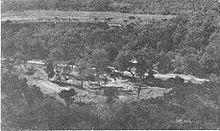
Mennonite
The Mennonites are a group of Christian Anabaptist denominations named after the Frisian Menno Simons , who, through his writings, articulated and thereby formalized the teachings of earlier Swiss founders...
s came into the Paraguayan part of the region from Canada
Canada
Canada is a North American country consisting of ten provinces and three territories. Located in the northern part of the continent, it extends from the Atlantic Ocean in the east to the Pacific Ocean in the west, and northward into the Arctic Ocean...
in the 1920s; more came from the USSR in the 1930s and immediately following World War II
World War II
World War II, or the Second World War , was a global conflict lasting from 1939 to 1945, involving most of the world's nations—including all of the great powers—eventually forming two opposing military alliances: the Allies and the Axis...
. These immigrants created some of the largest and most prosperous municipalities in the deep Gran Chaco.
The region is home to over nine million people, divided about evenly between Argentina, Bolivia, Brazil, and including around 100,000 in Paraguay. The area remains relatively underdeveloped, however; to help address this, in the 1960s the Paraguayan authorities had the Trans-Chaco Highway built and the Argentine National Highway Directorate, National Routes 16 and 81. All three highways extend about 700 km (435 mi) from east to west and are now completely paved, as are a network of nine Brazilian highways in Mato Grosso do Sul
Mato Grosso do Sul
Mato Grosso do Sul is one of the states of Brazil.Neighboring Brazilian states are Mato Grosso, Goiás, Minas Gerais, São Paulo and Paraná. It also borders the countries of Paraguay and Bolivia to the west. The economy of the state is largely based on agriculture and cattle-raising...
State.
Flora and fauna
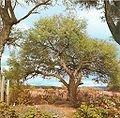
The floral characteristics of the Gran Chaco are varied given the large geographical span of the region. The dominant vegetative structure is xerophytic deciduous forests with multiple layers including a canopy, sub-canopy, shrub layer and herbaceous layer. There are ecosystems such as riverine forests, wetlands, savannas, and cactus stands as well..
At higher elevations of the eastern zone of the Humid/Sub-humid Chaco there are transitional mature forests from the wet forests of Southern Brazil. These woodlands are dominated by canopy trees such as Tabebuia impetiginosa
Tabebuia impetiginosa
Tabebuia impetiginosa, Pink Ipê or Pink Lapacho is a native Bignoniaceae tree of America, distributed from northern Mexico south to northern Argentina. It is a common tree in Argentina's northeastern region, as well as in southeastern Bolivia. It is said to be indigenous to Trinidad and Tobago.It...
and characterized by frequent lianas and epiphytes. This declines to seasonally flooded forests, at lower elevations, that are dominated by Schinopsis
Schinopsis
Schinopsis is a genus of South American trees in the family Anacardiaceae. The species within this genus inhabit different regions of the Gran Chaco ecoregion including parts of northern Argentina, Bolivia, and Paraguay....
spp., a common plains tree genus often harvested for its tannin
Tannin
A tannin is an astringent, bitter plant polyphenolic compound that binds to and precipitates proteins and various other organic compounds including amino acids and alkaloids.The term tannin refers to the use of...
content and dense wood. The understory comprises of bromeliad and cactus species as well as hardy shrubs like Schinus fasciculatus. These lower areas lack lianas but have abundant epiphytic species like Tillandsia
Tillandsia
Tillandsia is a genus of around 540 species in the Bromeliad family , found in the forests, mountains, and deserts, of Central and South America, and Mexico and the southern United States in North America....
.
The river systems that flow through the area, such as the Rio Paraguay and Rio Parana allow for seasonally flooded semi evergreen gallery forests that hold riparian species such as Tessaria integrifolia and Salix humboltiana. Other seasonally flooded ecosystems of this area include palm dominated (Copernicia alba
Copernicia alba
Copernicia alba is a South American species of palm tree, which is found in the humid part of the Gran Chaco ecoregion in Bolivia, Paraguay, Colombia, Brazil and Argentina . They often, but not always, form dense single-species woodlands...
) savannas with a bunch grass dominated herbaceous layer.
To the west, in the Semi-Arid/Arid Chaco, there are medium sized forests consisting of Aspidospermum quebracho-blanco and Schinopsis quebracho with a slighty shorter subcanopy made up of several species from the Fabaceae family as well as several arboreal cacti species that distinguish this area of the Chaco. There is a scrub-like shrub and herbaceous layer. On sandy soils, the thick woodlands turn into savannas where the aforementioned species prevail as well as species like Jacaranda mimosifolia. The giant Stetsonia coryne, found throughout the western Semi-Arid/Arid region becomes very conspicuous in these sandy savannas.
There are various upland systems of plant associations that occur throughout the Gran Chaco. The Highlands of the Argentenian Chaco are made up of, on the dry, sunny side (up to 1800m), Schinopsis haenkeana woodlands. The cooler side of the uplands hosts Zanthoxylum coco (locally referred to as Fagara coco
Fagara coco
Zanthoxylum coco is an evergreen tree of the Rutaceae family, natural of Argentina and Bolivia where it grows in the wild, mostly hilly, spinniferous forests...
) and Schinus molleoides (locally referred to as Lithrea molleoides) as the predominant species. Other notable species include Bougainvillea stipitata, and several spp. from Fabaceae
Fabaceae
The Fabaceae or Leguminosae, commonly known as the legume, pea, or bean family, is a large and economically important family of flowering plants. The group is the third largest land plant family, behind only the Orchidaceae and Asteraceae, with 730 genera and over 19,400 species...
. The Paraguyan uplands have other woodland slope ecosystems, notably, those dominated by Anadenanthera colubrina on moist slopes. Both of these upland systems, as well as a lot of other areas in the Gran Chaco are rich with endemism.
Faunal diversity in the Gran Chaco is high as well. Animals regularly associated with tropical and subtropical forests are often found throughout the eastern humid chaco including jaguars, howler monkeys, peccaries, deer, and tapirs. Edentate species, including anteaters and armadillos are readily seen here as well..
Being home to at least ten species, armadillos are at their peak diversity in the Argentenian Chaco. Included in the species present are both the Nine-banded Armadillo
Nine-banded Armadillo
The nine-banded armadillo , or the nine-banded, long-nosed armadillo, is a species of armadillo found in North, Central, and South America, making it the most widespread of the armadillos...
(Dasypus novemcinctus) whose range extends north to the southern US, and the Southern Three-banded Armadillo
Southern Three-banded Armadillo
The Southern Three-banded Armadillo , also called the La Plata Three-Banded Armadillo, is an armadillo species from South America...
(Tolypeutes matacus).. The Pink Fairy Armadillo (Chlamyphrous truncates), is found nowhere else in the world.. The Giant Armadillo (Priodontes maximus), while not found in the eastern humid Chaco, can be seen in the drier arid Chaco of the west.
Some other notable endemics of the region include the San Luis Tuco-tuco
San Luis Tuco-tuco
The San Luis Tuco-tuco is a species of rodent in the family Ctenomyidae.It is endemic to Argentina....
(Ctenomys pontifex). This small rodent is only found in the Argentenian Chaco. All of 60 species of Ctenomys are endemic to the continent of South America. The Chacoan Peccary (Catagonus wagneri), locally known as tauga, is the largest of the three peccary species found in the area. This species was thought to be extinct by scientists until 1975, when it was recorded by Dr. Ralph Wetzel.
Due to the climatic regime of the Gran Chaco, herptopfauna are restricted to moist refugium
Refugium
Refugium may refer to:* Refugium , an appendage to a marine, brackish, or freshwater fish tank that shares the same water supply...
in various places throughout the chaco. Rotting logs, debris piles, old housing settlement, wells, and seasonal farm ponds are examples of such refugia.
The Black-legged Serieman (Chunga burmeisteri), Blue-crowned Parakeet
Blue-crowned Parakeet
The Blue-crowned Parakeet, Blue-crowned Conure, or Sharp-tailed Conure is a parakeet native to large parts of South America, from eastern Colombia in the north to northern Argentina in the south...
(Aratinga acuticadauta), Picui Ground Dove (Columbina picui), Guira Cuckoo (Guira guira), Little Thornbird
Little Thornbird
The Little Thornbird is a species of bird in the Furnariidae family.It is found in Argentina, Bolivia, Paraguay, and Uruguay....
(Phacellodomus sibilatrix) and Many-colored Chaco Finch (Saltaitricula multicolor) are notable of the 409 bird species that are resident or breed in the Gran Chaco. 252 of these chaco species are endemic to South America.
In September 1995, the Kaa Iya del Gran Chaco National Park was established in an area of the Chaco in Bolivia. It is administered and was established solely by the indigenous peoples, including the Izoceño Guaraní, the Ayoreode, and the Chiquitano.
Conservation Issues
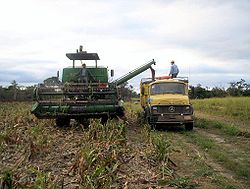
Menno Colony
Menno Colony is a settlement founded by Russian Mennonites in 1926 in the central Chaco of northwest Paraguay occupying an area of 7500 km² . Neighbouring Mennonite settlements are Fernheim Colony and Neuland Colony.- History :...
are a notable exception.
Two factors may substantially change the Chaco in the near future: low land valuations
and the region's suitability to grow fuel crops
Energy crop
An energy crop is a plant grown as a low cost and low maintenance harvest used to make biofuels, or combusted for its energy content to generate electricity or heat. Energy crops are generally categorized as woody or herbaceous ....
.
Suitability for the cultivation of Jatropha
Jatropha
Jatropha is a genus of approximately 175 succulent plants, shrubs and trees , from the family Euphorbiaceae. The name is derived from the Greek words ἰατρός , meaning "physician," and τροφή , meaning "nutrition," hence the common name physic nut. Mature plants produce separate male and female...
has been proven.
Sweet sorghum
Sweet sorghum
Sweet sorghum is any of the many varieties of sorghum which have a high sugar content. Sweet sorghum will thrive better under drier and warmer conditions than many other crops and is grown primarily for forage, silage, and syrup production....
as an ethanol plant may prove viable, too, since sorghum is a traditional local crop for domestic and feedstock use. The feasibility of switchgrass
Switchgrass
Panicum virgatum, commonly known as switchgrass, is a perennial warm season bunchgrass native to North America, where it occurs naturally from 55°N latitude in Canada southwards into the United States and Mexico...
is currently being studied by Argentina’s INTA
Instituto Nacional de Tecnología Agropecuaria
The National Agricultural Technology Institute , commonly known as INTA, is an Argentine federal agency in charge of the generation, adaptation and diffusion of technologies, knowledge and learning procedures for the agriculture, forest and agro-industrial activities within an ecologically clean...
, as is the Karanda’y palm tree
Copernicia alba
Copernicia alba is a South American species of palm tree, which is found in the humid part of the Gran Chaco ecoregion in Bolivia, Paraguay, Colombia, Brazil and Argentina . They often, but not always, form dense single-species woodlands...
in the Paraguayan Chaco.
While advancements in agriculture will bring some improvements in infrastructure and employment for this traditionally rather neglected and impoverished region, loss of habitat / virgin forest is substantial. Paraguay, after having lost more than 90% of its Atlantic Rainforest between 1975 and 2005, is now losing its xenopheric forest (dry forests) in the Chaco at an annual rate of 220.000 hectare (2008)
In mid 2009 a projected law, initiated by the Libiral Party, that would have outlawed deforestion in the Paraguay Chaco altogether, "Deforestacion Zero en el Chaco" did not get a majority in the Paraguay Parlament.
Deforestation in the Argentinian part of the Chaco amounted to an average of 100.000 hectares per year between 2001 and 2007
Administrative divisions in the Gran Chaco
.jpg)
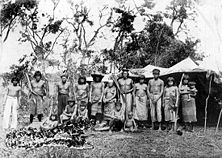
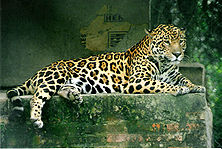
- Chaco ProvinceChaco ProvinceChaco is an Argentine province located in the north of the country, near the border with Paraguay. Its capital is Resistencia on the Paraná River opposite the city of Corrientes...
, Argentina - Formosa ProvinceFormosa ProvinceFormosa Province is in northeastern Argentina, part of the Gran Chaco Region. Its northeast end touches Asunción, Paraguay, and borders the provinces of Chaco and Salta to its south and west, respectively...
, Argentina - Salta ProvinceSalta ProvinceSalta is a province of Argentina, located in the northwest of the country. Neighboring provinces are from the east clockwise Formosa, Chaco, Santiago del Estero, Tucumán and Catamarca. It also surrounds Jujuy...
, Argentina - Santa Fe ProvinceSanta Fe ProvinceThe Invincible Province of Santa Fe, in Spanish Provincia Invencible de Santa Fe , is a province of Argentina, located in the center-east of the country. Neighboring provinces are from the north clockwise Chaco , Corrientes, Entre Ríos, Buenos Aires, Córdoba, and Santiago del Estero...
, Argentina - Santiago del Estero ProvinceSantiago del Estero ProvinceSantiago del Estero is a province of Argentina, located in the north of the country. Neighbouring provinces are from the north clockwise Salta, Chaco, Santa Fe, Córdoba, Catamarca and Tucumán.-History:...
, Argentina - Tucumán ProvinceTucumán ProvinceTucumán is the most densely populated, and the smallest by land area, of the provinces of Argentina. Located in the northwest of the country, the capital is San Miguel de Tucumán, often shortened to Tucumán. Neighboring provinces are, clockwise from the north: Salta, Santiago del Estero and...
, Argentina - Beni DepartmentBeni DepartmentBeni, sometimes El Beni, is a northeastern department of Bolivia, in the lowlands region of the country. It is the second largest department in the country , covering 213,564 square kilometers , and it was created by supreme decree on November 18, 1842 during the administration of General José...
, Bolivia - Chuquisaca DepartmentChuquisaca DepartmentChuquisaca is a department of Bolivia located in the center south. It borders on the departments of Cochabamba, Tarija, Potosí, and Santa Cruz. The departmental capital is Sucre, which is also the constitutional capital of Bolivia.-Geography:...
, Bolivia - Santa Cruz DepartmentSanta Cruz DepartmentSanta Cruz, with an area of 370,621 km², is the largest of the nine constituent departments of Bolivia. In the 2001 census, it reported a population of 2,029,471. The capital is the city of Santa Cruz de la Sierra. The state is one of the wealthiest states in Bolivia with huge reserves of...
, Bolivia - Tarija DepartmentTarija DepartmentTarija is a department in Bolivia. It is located in south-eastern Bolivia bordering Argentina to the south and Paraguay to the east. According to the 2001 census, it has a population of 391,226 inhabitants. It has an area of 37.623 km²...
, Bolivia - State of Mato Grosso do SulMato Grosso do SulMato Grosso do Sul is one of the states of Brazil.Neighboring Brazilian states are Mato Grosso, Goiás, Minas Gerais, São Paulo and Paraná. It also borders the countries of Paraguay and Bolivia to the west. The economy of the state is largely based on agriculture and cattle-raising...
, Brazil - Alto Paraguay DepartmentAlto Paraguay DepartmentAlto Paraguay is a sparsely populated department of Paraguay. The capital is the town of Fuerte Olimpo.In 1992 the Chaco Department was merged with Alto Paraguay, effectively recreating the original department Olimpo as it existed until 1945....
, Paraguay - Boquerón DepartmentBoquerón DepartmentBoquerón is a department in the western region of Paraguay. It is the country's largest department, with an area of , but its population is only 45,617 . The department includes the Russian Mennonite colonies of Fernheim, Menno and its administrative center Loma Plata and Neuland. The capital is...
, Paraguay - Presidente Hayes DepartmentPresidente Hayes DepartmentPresidente Hayes is a department in Paraguay. The capital is the city of Villa Hayes. The department was named after U.S. President Rutherford B. Hayes, who was the arbitrator in a boundary dispute between Paraguay and Argentina after the War of the Triple Alliance.-Districts:The department is...
, Paraguay
Indigenous peoples of the Gran Chaco
- AbipónAbipón peopleThe Abipones were an indigenous nation of Argentina's Gran Chaco, part of the Guaycuru languages linguistic group. They ceased to exist as an ethnic group in the early 19th century...
, Argentina, historic group - Angaite (Angate), northwestern Paraguay
- AyoreoAyoreoThe Ayoreo are a native ethnic group living on Gran Chaco, in an area among rivers Paraguay, Pilcomayo, Parapetí and Grande, stretching both in Bolivia and Paraguay. They speak the Ayoreo language, which is classified under Zamucoan, a small language family of Paraguay and Bolivia...
(Morotoco, Moro, Zamuco), Bolivia and Paraguay - Chamacoco (Zamuko), Paraguay
- Chané, Argentina and Bolivia
- Chiquitano (Chiquito, Tarapecosi), eastern Bolivia
- Chorote (Choroti), Iyojwa'ja ChoroteIyojwa'ja ChoroteEklenhui is a language spoken in northeast Salta province in Argentina by 800.It is also known as Choroti, Yofuaha, and Eklenjuy.It is distinct from the similarly named Iyo'wujwa Chorote.-External links:*...
, Manjuy), Argentina, Bolivia, and Paraguay - Guana (Kaskihá), Paraguay
- Guaraní, Argentina, Bolivia, Brazil, and Paraguay
- Bolivian Guarani
- Chiriguano, Bolivia
- GuarayoGuarayo peopleGuarayos is a Bolivian word for "savages" used for speakers of Tupian languages, such as the indigenous peoples of Guarayos Province in central Bolivia, who number some 20,000.-References:*http://ipsnews.net/news.asp?idnews=40615...
(East Bolivian Guarani)
- Chiripá (Tsiripá, Ava), Bolivia
- Pai Tavytera (Pai, Montese, Ava), Bolivia
- Tapieté (Guaraní Ñandéva, Yanaigua), eastern Bolivia
- Yuqui (Bia), Bolivia
- Bolivian Guarani
- Guaycuru peoplesGuaycuru peoplesGuaycuru or Guaykuru is a generic term for several ethnic groups indigenous to the Gran Chaco region of South America, speaking several related Mataco–Guaycuru languages....
, Argentina, Bolivia, Brazil, and Paraguay- Mbayá (Caduveo), historic
- KadiweuKadiweu peopleThe Kadiweu are an ethnic group indigenous to the Gran Chaco region of South America, presently living in Southwest Brazil. As of 1998, they numbered about 1500 people, divided into four villages....
, Brazil
- Kadiweu
- Mocoví (Mocobí), Argentina
- Pilagá (Pilage Toba)
- Toba (Qom, Frentones), Argentina, Bolivia, and Paraguay
- Mbayá (Caduveo), historic
- KaiwáKaiwáKaiwá is a Guarani language spoken by about 18,000 in Brazil in the state of Mato Grosso do Sul, 15,000 in Paraguay , and 500 in Argentina. Literacy is 5-10% in Kaiwá and 15–25% in Portuguese. Kaiwá proper is 70% lexically similar with the Pai Tavytera dialect, and is somewhat intelligible with...
, Argentina and Brazil - Lengua people (EnxetEnxetThe Enxet are an indigenous people of about 17,000 living in the Gran Chaco region of western Paraguay. Originally hunter-gatherers, many are now forced to supplement their livelihood as laborers on the cattle ranches that have encroached upon their dwindling natural forest habitat...
), Paraguay- North Lengua (Eenthlit, Enlhet, Maskoy), Paraguay
- South Lengua, Paraguay
- Lulé (Pelé, Tonocoté), Argentina
- Maká (Towolhi), Paraguay
- NivacléNivacléNivaclé is a Matacoan language spoken in Paraguay by c.8,400 and in Argentina by 200. It is also known as Chulupí and Ashluslay, and in older sources has been called Ashuslé, Suhin, Sujín, Chunupí, Churupí, Choropí, and other variant spellings of these names...
(Ashlushlay, Chulupí, Chulupe, Guentusé), Argentina and Paraguay - SanapanáSanapanaThe Sanapana were one of many nomadic tribes inhabiting the lower Gran Chaco of western Paraguay. With the introduction of Mennonite settlements in the central Chaco in the 1930s, many nomadic tribes semi-settled near the Mennonites. The Mennonites established Missions to many of these tribes,...
(Quiativis), Paraguay - Vilela, Argentina
- Wichí (Mataco), Argentina and Bolivia
External links
- The National Museum of Natural History's description of Gran Chaco
- Chaco ecoregion (World Wildlife Fund)
- Humid Chaco ecoregion (World Wildlife Fund)
- Food and Agriculture Organization of the United Nations' description of the Gran Chaco - focuses mainly on agriculture.
- Some stamps showing the dispute over the Gran Chaco before the war - some people claim this was the spark that ignited the war
- photos of the Paraguay Chaco
- The website La Plata Basin - Gran Chaco seeks to enhance the complementarity between institutional capacities and ongoing projects in the region so as to strengthen synergies, develop replicable and scalable initiatives, and improve participatory management with communities from the perspective of sustainability and equity.

